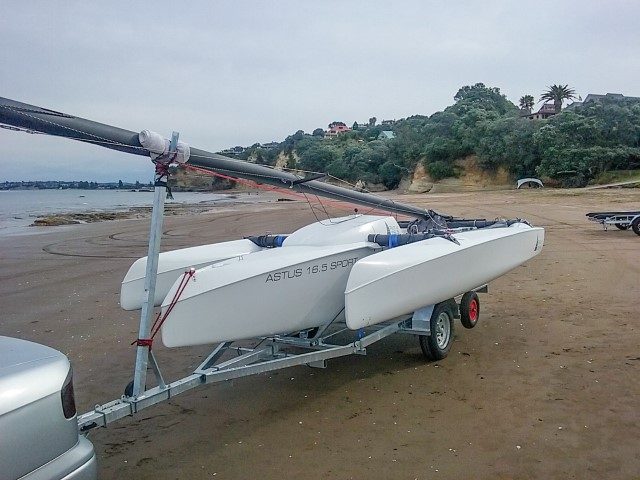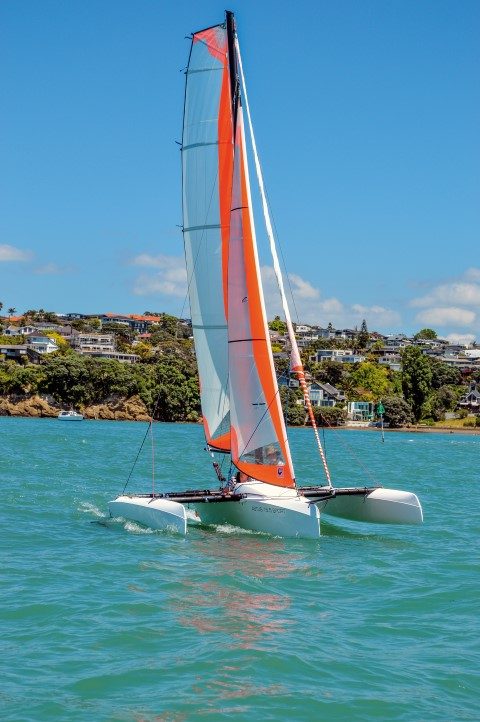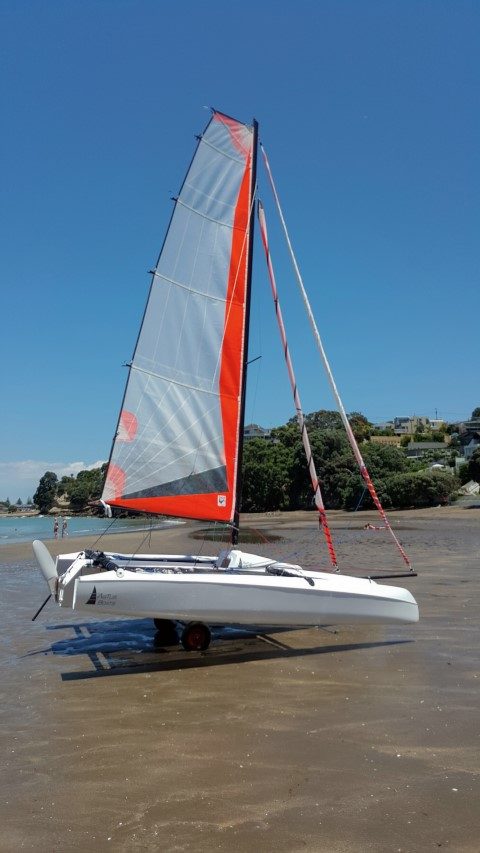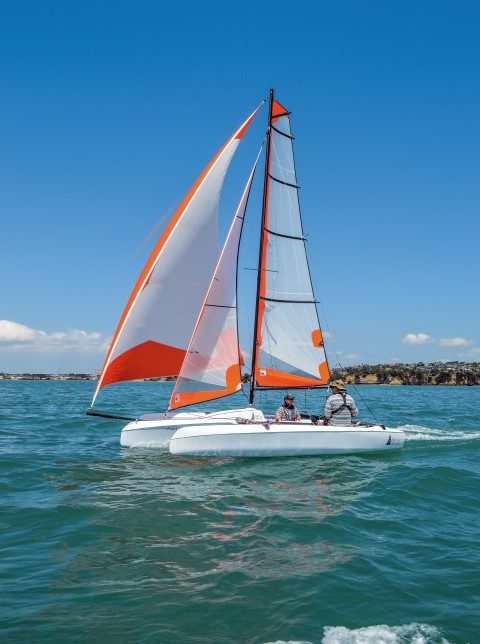She feels really easy and comfortable to sail, even in a good breeze and a chop.
- Lightweight
- Fast and fun
- Easy to tow and rig
- Integrated beach trolly
- Easy to tow
- Wet sailing
- Generous deck space

Easy to tow, simple to rig, quick to launch – topped by a generous splash of adrenalin-inducing performance. A trimaran for the modern family.
In the 70s and 80s there were two boating revolutions which ran simultaneously. The first was the trailer-sailer revolution which promised an affordable way to get the family out sailing in comfort. The other revolution was the beachcat one. It offered high speed, fluorescent sails and get-wet fun and was championed by a surfer and thumbed its nose at the yachting establishment.
It has taken until now to blend the best of the two into a small trailerable trimaran which is starting a revolution of its own. The French company Astus is one of a handful of companies that has developed quality trailerable trimarans that are fun and affordable.

With the Astus 16.5 Sport it has combined production nous with the design excellence of VPLP Naval architecture which is at the forefront of modern MOD70 Multihull design. The result is a stylish and simple family fun machine that’s easy to transport and is exciting to sail.
Construction
Astus has been in the business of building production trailerable trimarans since 2004. Both the main hull and the floats are laid up in a female mould as hull and deck units. While the standard hulls are polyester resin there is an option for a lighter, racer Sport+ model which uses the infusion process to achieve a lighter finish weight.
There are plenty of ring frames and reinforcement around beam, daggerboard case and mast-step areas, and the hull and decks are joined down the distinctive reverse sheerline to the wave-piercing bows. The attention to detail means that the finish on the hulls is impeccable with no bold seams or weak points.

The beams are given the same treatment with aluminum sleeves with plastic sheaths inside them to make extending the beams a smooth operation. The beams are locked with a pin system, which makes them strong and easy to use in both sailing and trailing mode.
Layout
The Astus is a big little boat. Folded and on the trailer there is not much to her. At 210kg she is light and compact and the sort of thing you forget you are towing. With this size of boat there is no need for the complexity of folding beams. The beams are telescoped in and held with a pin while the trampolines concertina nicely with them. In folded mode she is 2.5m wide and unfolded she blossoms to 3.8m, which equates to an enormous 8m2 of deck space.
The nicely-balanced road trailer holds a beach trolley which is locked to the main trailer for road travel. It’s a simple job to launch her off the road trailer and onto the beach and this ingenious design means that the road trailer does not need to go anywhere near the water. The odious bearing problems of the trailer-sailer fraternity are eliminated in one, well-designed swoop.

On the beach trolley she looks and feels more like a beach cat than trailer-sailer. At just over 7m the rotating mast can be raised by one person without any of the complications of block and tackle or winches.
With the boat unfolded there is a tennis court like feel which is not what you are expecting on a 16-footer. The self-draining cockpit is long and gives the boat an uncluttered aspect; it also gives the luxury of a footwell so that a variety of seating combinations can be utilised. The daggerboard fits into its case in the forward sections of the cockpit. It is unobtrusive and efficient.
On the sugar-scoop stern there is a bracket for an outboard, and given the easily-driven hull, a simple 2hp would do the job. The traveller sits atop the aft beam and is complemented by a powerful Ronstan 6:1 Mainsheet.
The tiller terminates immediately behind the aft beam and contains an extendable Ronstan tiller extension which allows the skipper to helm from out on the windward hull or relax in the cockpit. The transition from deck to trampoline is seamless, which allows you to move weight around the boat without much effort.

All halyards and the mast rotation controls are on the mast and boom which keeps the deck clear and functional. The mast is stepped onto the cuddy cabin top and supported by an internal ring frame.
The cuddy is large enough for one non-claustrophobe to sleep in, but the wing decks look a more comfortable proposition for overnight camping. Having a Plastimo hatch on the cuddy means that all the gear will remain dry no matter how much spray is thrown around on deck.
On the bow the carbon prod is secured by a stainless loop and a channel that is moulded into the deck while the 5.5m2 furling jib is fastened by a solid ring bolt to the fore deck. With 17m2 of working sail area and a 20m2 screecher, the sails are manageable and there is no need for winches of any kind. Ronstan cam cleats hold the jib sheets and the screecher is trimmed on dual Ronstan ratchet blocks through a double-purchase.
Buoyant-looking floats each have 500 litres of volume, which bodes well for a stiff, safe boat. They also have an angle moulded in them for hiking and are finished off with inspection hatches on topside and transom.
On the water
Test day greeted us with a fitful sea breeze of 5-8 knots off Auckland’s Castor Bay. The Astus was easy to launch on her beach trolley into a moderate northeasterly slop that would have had trailer sailer owners sweating.
From the photo boat she was not difficult to miss as her bright orange Mylar sails and her sleek French styling cut quite a dash. Indeed, it was hard to take a bad shot of her, no matter what angle we were on, her lines were both striking and efficient.
Much like the MOD 70s, her hulls contain flat sections which give good buoyancy. The main hull bends this flat section into an upward sheerline which meets the decks reverse sheer. The result is that the faster you go the more the main hull bow rides up and this bodes well for her heavy weather performance.

On board the Astus the sensation is of space. The 16.5 Sport has been designed to sail with two, but, such is the width of the wing decks and the volume of the hulls, having three aboard is no great burden. There is an immediate impression of uncluttered simplicity with the vital sheets and controls easy to get to from the helm position at the aft end of the cockpit.
On the wind the Astus accelerates quickly. The helm is light and responsive, but like most multihulls she will not tolerate pinching. The pointing was good due to the 1.1m daggerboard and the ability to get leech tension into the main through the mainsheet purchase system.

To tweak the rig tension further would require the simple addition of some adjustable blocks for the back-stays. Helming from out on the windward hull with the tiller extension gives you a great view of the sail trim and in this mode she rewarded us with bursts not far off wind speed.
Off the wind with the screecher unfurled the Astus really comes to life. The deep rudder has a good grip and you can hunt the lulls and drive off in the puffs to keep your apparent wind up.
The screecher effectively doubles the sail area and we were able to get up to 12 knots on a broad reach. The ride was wet and exciting but without any tendency to bury the leeward bow thanks to the volume and flat sections beneath the waterline. If the family is aboard she can easily be tamed down to a more sedate pace to keep the crew happy.

The Astus 16.5 Sport is about wet fun. She is faster than most everything on the water and I suspect the harder it blows the more fun you will have. She is a blend of the best bits of the trailer-sailer and the beach cat revolutions and is a sailor’s boat for those who love performance, simplicity and hooting out loud.
She feels really easy and comfortable to sail, even in a good breeze and a chop.
At first glance the boat appears to be a large centre console, although hidden beneath the console and forward area is a sizeable overnight cabin.
With classic styling, good performance and class-leading ride and handling, there’s a lot to like about the Caribbean 32.
Solar panels on the vast roof help keep the batteries charged.